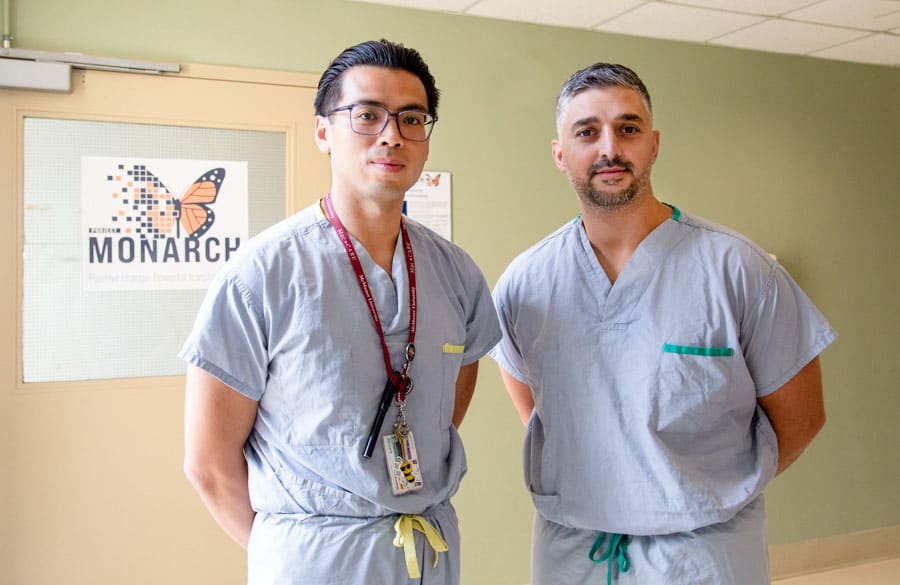
Orthopedic Surgeon Dr. Anthony Habib (right) is with Dr. Ben Tam, Digital Strategy Physician Lead with Niagara Health's new Hospital Information System, at the HIS team's headquarters in Niagara Falls. Dr. Habib has worked at other hospitals during their transition to a fully digital patient record system and says the changes are for the better for physicians and patients alike.
As Niagara Health counts down to the go-live day for our new Hospital Information System on Nov. 9, doctors who have been through this before are offering up some assurances that this big change is for the better.
Dr. Anthony Habib, an orthopedic surgeon at Niagara Health, was at St. Joseph’s Healthcare in Hamilton during its HIS changeover. In fact, when Niagara Health’s HIS goes live this fall, it will be Dr. Habib’s fourth experience working at a hospital making the shift.
There were challenges with every switch to a fully digital system, he says. Giving oneself grace as staff and patients adapt to the new technology is essential.
“It takes about six months to get into a groove with it, but being able to document all notes and have a clear understanding of a patient if they have to come back to the hospital is important,” Dr. Habib says. “The information is all written out clearly.”
To help with the transition, Niagara Health will have at-the-elbow support staff to troubleshoot with care teams as they learn the software.
Dr. Habib looks forward to HIS software capabilities that will make basic follow-up easier, eliminate paper orders, speed up medical and prescription orders, and save time going into the hospital from his off-site office to manually enter information.
“This is going to be a great system for the future,” Dr. Habib says. “It’s good for Niagara Health. It’s going to be a step up from what we have, for sure.”
Dr. Michael Au, a surgeon at St. Joe’s with a background in informatics, who went through the transition with Hamilton Health Sciences, echoes Dr. Habib about the benefits of an HIS for Niagara Health patients. Healthcare providers at the hospital will always have a fulsome picture of a patient instead of information being siloed or disjointed, or kept with one practitioner even when a patient comes into the hospital for another service.
Patients will also be able to access their own health records through the HIS, unless they opt out, enabling them to become active participants in their care.
“Patients can come into appointments armed with more information about what their results may show so they are more informed and more involved,” Dr. Au says.
“This is moving forward to catch up with other hospitals and there are benefits you won’t realize starting off,” he adds. “But once it’s going, the benefits will extend beyond staff to patients. Most people will find that transitioning to something bigger like this has significant benefits.”
The benefits of a Hospital Information System (HIS)
- Provide easy access by care teams to a patient's medical record, including information about their condition, allergies, medications, past visits and more.
- Enhance patient safety by eliminating the need to search for a patient's chart, write paper orders or decipher handwriting. Care providers also have access to the information they need to inform their health decisions and errors are reduced.
- Reduce duplication and repetition by offering just one source of truth. Patients won't need to repeat their health history or story over and over, and all of their care providers will have access to the same information, including diagnostic tests, medications and other important knowledge.
- Enrich patient communication by enabling patients to access their own health records and resources, allowing them to share that information with other healthcare practitioners. They can also access health education materials and, in collaboration with other Niagara Health digital tools, communicate securely with their care team.
- Allow data to drive decisions by using analytics, trends and other important data to offer clinical direction and allow for alerts. This will make care more efficient and optimize decision-making.

